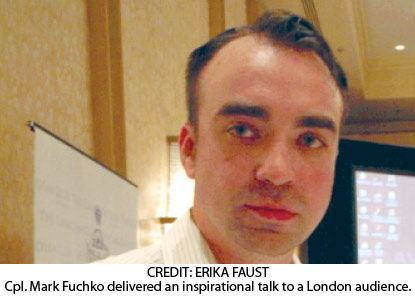A solider shares his story

In late September, Cpl. Mark Fuchko stood in front of a packed room, relaying his tales of being a soldier in Afghanistan. Clad in jeans and a button-up shirt, an outfit punctuated with splashes of colour from the tiki-themed tattoos covering his right arm, Fuchko captivated his audience with his stories, pictures and memories.
Fuchko is an amazing guy by pretty much anybody's standards: this past summer, he climbed Mt. Kilimanjaro as part of a fundraising effort for the Royal Alexander Hospital in Edmonton and met Prince William and his new bride Kate; he has kayaked from Seattle to Vancouver; and he has plans to hike Mt. Everest in the next year. What makes all of this even more remarkable is that two years ago, he spent an entire year re-learning how to walk after losing his legs below the knee to an Improvised Explosive Device in Afghanistan in 2008.
Fuchko, who is from Calgary, joined the army reserves with friends in 2002 when he was 18. "It seemed like a cool job, and after 9/11, we all wanted to go kick some ass," he recalled.
In December 2005, he was deployed on his first tour to Afghanistan as a rifleman in the National Command Element Security Platoon, spending most of his time at the Kandahar Provincial Reconstruction Team, an organization that helps the people of Afghanistan rebuild their country after war.
"There's a big fallacy that every Canadian soldier can go to Tim Horton's in Afghanistan — this, in fact, is wrong," he said. He remembered when some person or organization had the "bright idea" to send Roll up the Rim cups to soldiers in Afghanistan so they could experience the fun and rage that plague Canadians each year. Though he didn't win anything, he said his friend won a GPS, but he had to claim it the next day, which obviously couldn't happen. "A lot of guys who spend time (there) get really, really mad when people talk about Tim Horton's," he laughed.
Two years later, he was augmented to B Squadron of Lord Strathcona's Horse and was employed as tank driver in Canada, Germany and Afghanistan. During that second tour, he said, he was never supposed to go to Afghanistan — he was supposed to go to Dubai for six months. "It sounded like a great vacation to me!" he laughed. "I was in (Dubai) for about four hours, and then I had to go to Afghanistan for four and a half months."
In late March in 2008, he was driving his Leopard 2 tank when he lost his route clearance package, meaning he could not take the road he meant to. Instead, he drove through a farmer's field. He said his group must have been observed in their position by insurgents, who placed a massive IED in the path the tank had cut, hoping the group would take the same road back. "The golden rule they tell you in the military is never, ever, ever, ever use the same route twice," Fuchko said, but that day, he did. "I was in command that day and I had to pay the price."
The IED blasted a one-metre hole in the tank, trapping Fuchko and maiming his legs. He remembered one leg being folded up so he could see the bottom of his boot. Luckily he remembered the importance of tourniquets, which he tightened around each leg. He said the army tells people that "(tying the tourniquet) could be the last thing you do before you black out — it could save your life."
Fuchko was trapped in the stillrunning tank for 45 minutes. "I was convinced I was gonna die," he said. His number one concern? "My mom is going to kill me." Eventually, with the help of an Armed Recovery Vehicle, the tank's hatch was ripped off and Fuchko was brought to safety.
He was transported to Landstuhl Regional Medical Center in Germany, where both his legs were amputated below the knee. He was then sent back to Canada, where he received treatment at the Foothills Medical Centre and University of Alberta Hospital, then went to the Glenrose Rehabilitation Hospital in Edmonton. After over a year of rehabilitation, he could walk with prosthetic legs. "I really miss small things; I miss putting new socks on, I miss walking on the beach."
Along with sharing his stories and memories, Fuchko showed some of the pictures he has taken. Though his camera was blown up in the tank, some of the pictures survived. He showed photos of makeshift bombs, explosive devices and a car full of bombs, abandoned by a would-be suicide bomber who "chickened out" (a discovery that gave the army a trove of intel on how the bombs were built). He showed a picture of a mushroom cloud from an explosion, and he showed the exploded interior of his tank after hitting the IED, with parts of his legs he left behind. He showed photos of the friends who never made it back. He showed photos of himself all over the world, in Yugoslavia, Cyprus, Egypt and more.
Today, Fuchko is a part-time student at Mount Royal University and is currently employed by The Lord Strathcona's Horse Museum in Calgary.
Cpl. Mark Fuchko came to London as part of the Canadian Club of London's series of remarkable Canadian speakers. For more information about upcoming events or to join the Canadian Club of London, visit canadiancluboflondon.ca.













